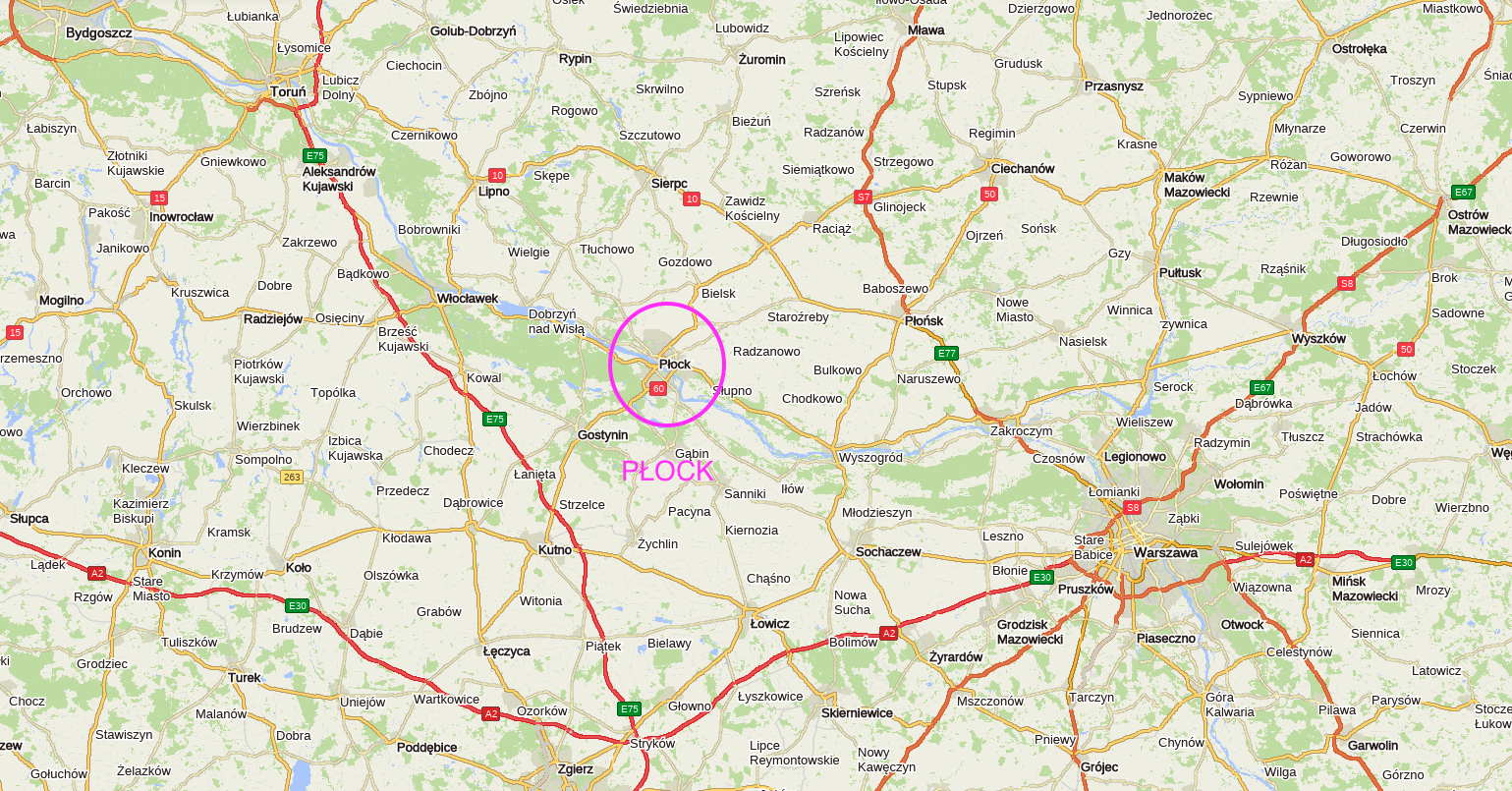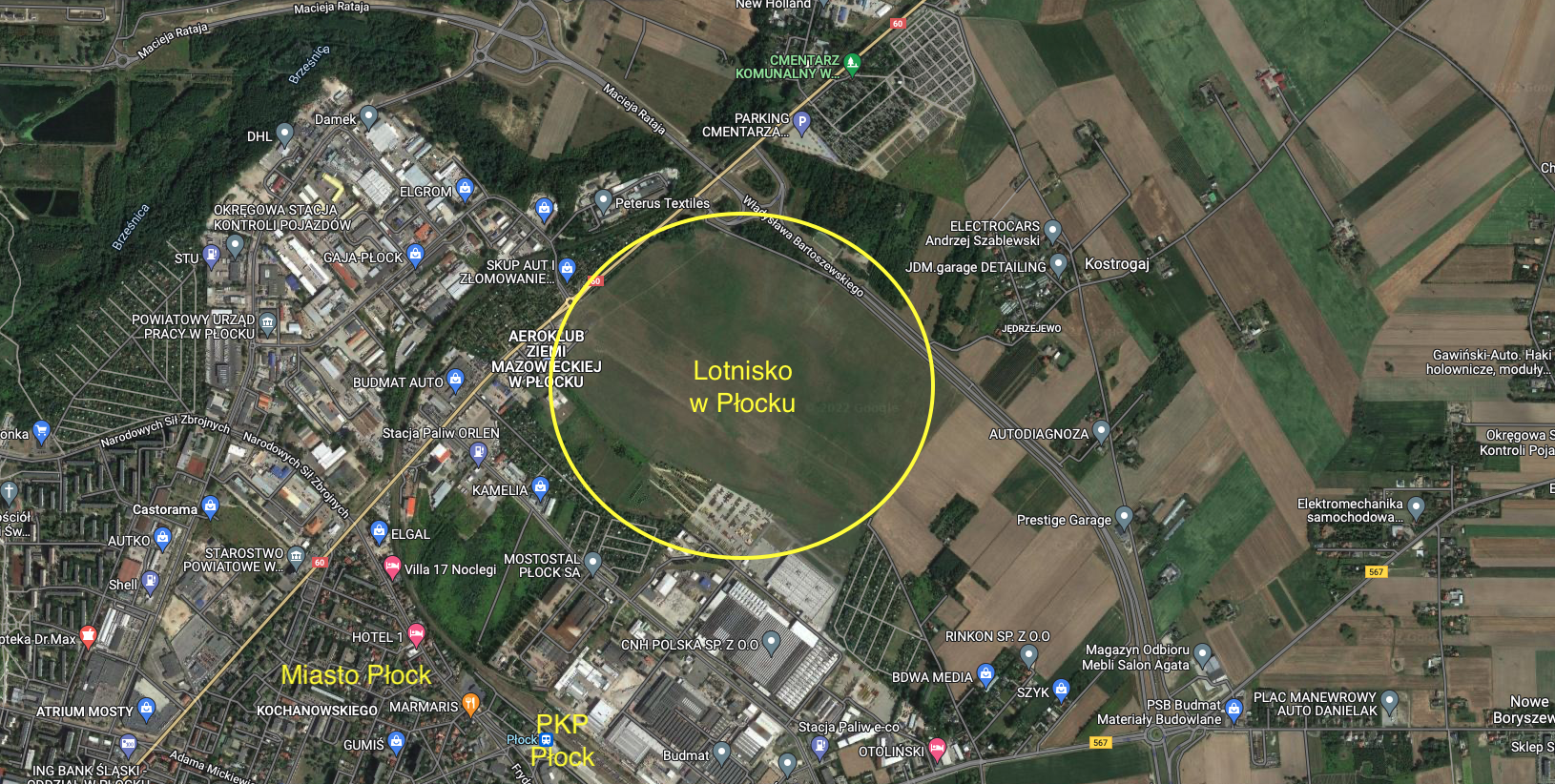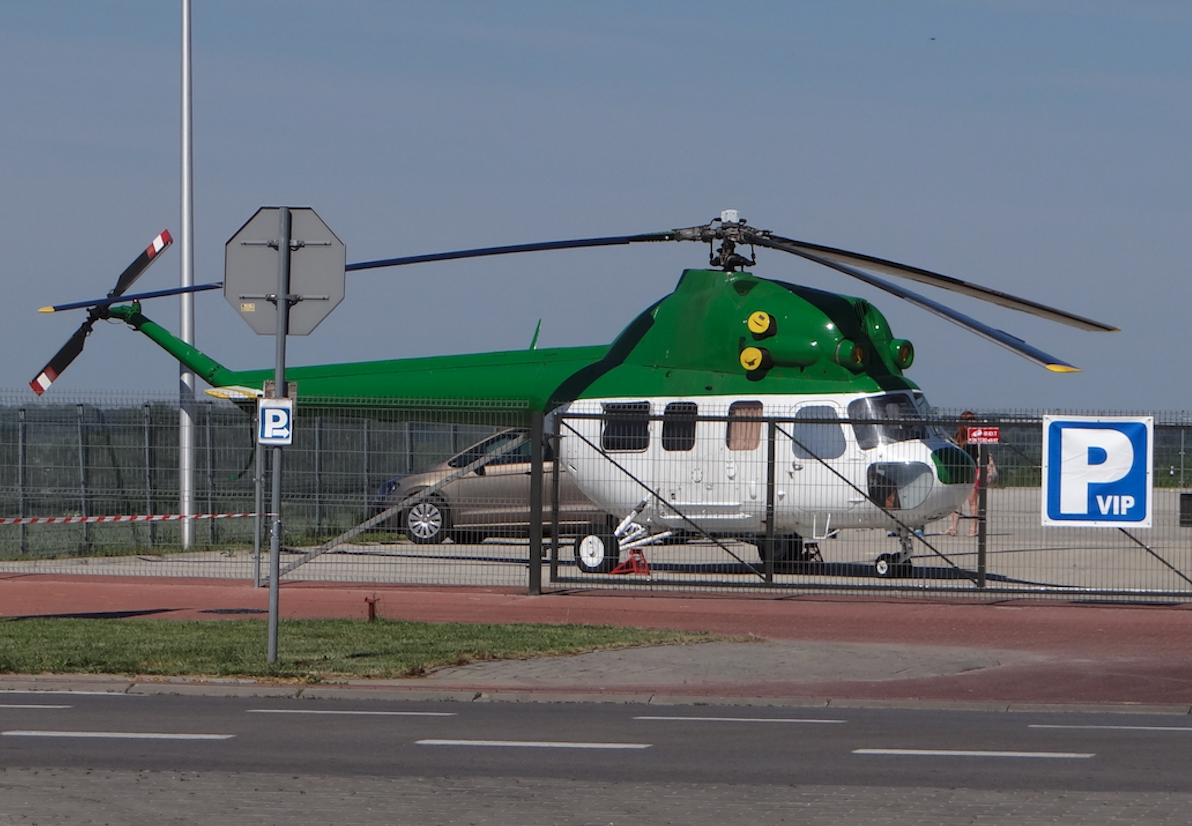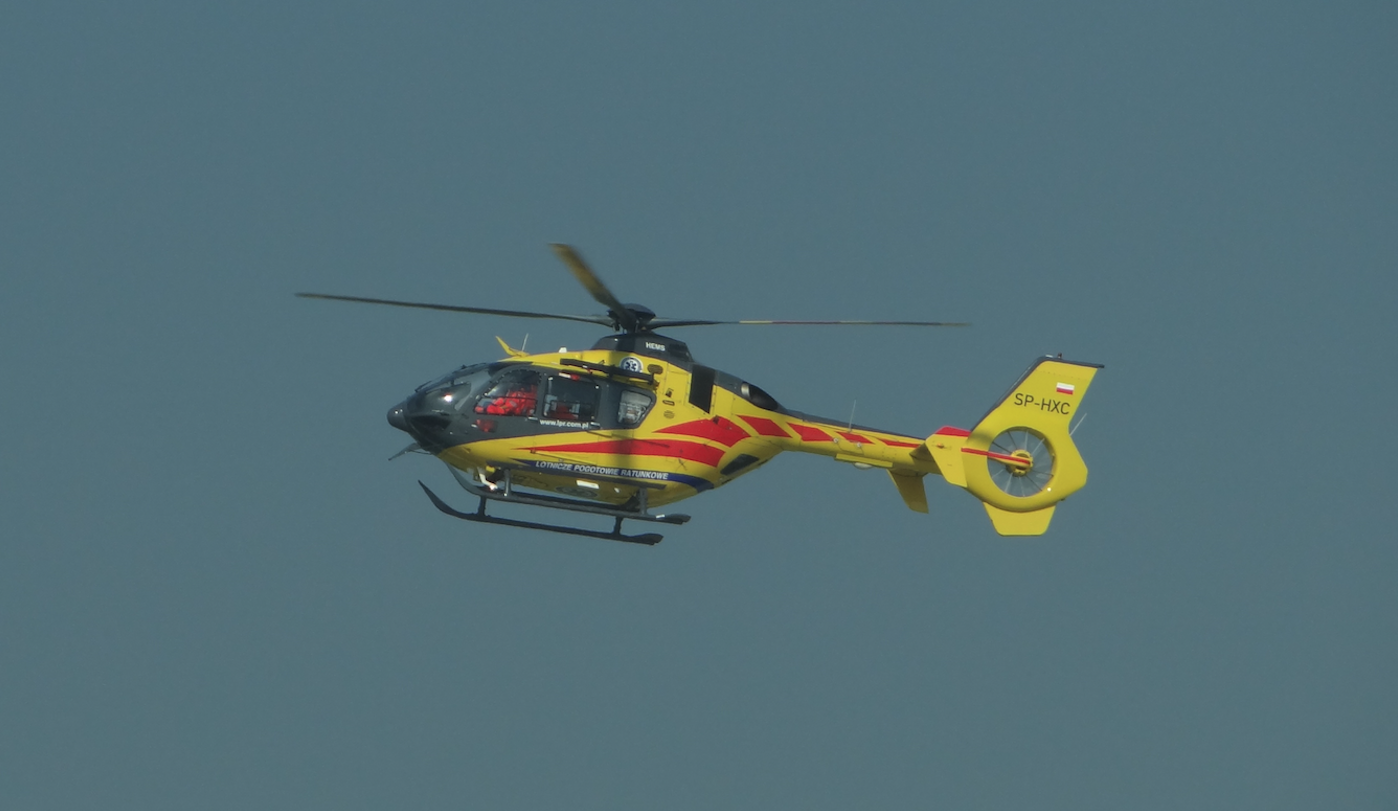Płock 2022-12-06
Lotnisko w Płocku.
Płock to Polskie miasto, które ma 1 000-letnią historię i był także stolicą Polski. Płock do duże miasto w środkowej Polsce, które obecnie jest na prawach powiatu. Miasto położone jest na Pojezierzu Dobrzyńskim, w Kotlinie Płockiej, nad rzeką Wisłą, w Województwie Mazowieckim. Mieszkańcem Płocka był pilot myśliwski Jan Zumbach, który był dowódcą legendarnego Dywizjonu 303. W 2013 roku, Płock liczył 123 000 mieszkańców, a w 2020 roku 118 628 osób. Powierzchnia miasta to 88,04 km2. Wysokość nad poziomem morza od 58 m do 105 m.
Historia Płocka.
Początki miasta Płock sięgają IX wieku. Do osadnictwa w tym miejscu ludności skłoniły dogodne tereny do życia i obrony. Najważniejsze było Wzgórze Tumskie o wysokości około 50 m od lustra wody Wisły. Ale wiosenne wylewy Wisły często uszkadzały skarpę wzgórza, przez co były tutaj osuwiska. Obszar dzisiejszego Płocka razem z Mazowszem wszedł w obręb państwa Piastów. Na Wzgórzu Tumskim powstał książęcy gród warowny. Obok grodu powstała osada handlowa i rybacka.
Chwilowo Piastowie utracili kontrolę nad Płockiem, ale już w 1047 roku, gród został ponownie wcielony do Polski przez księcia Kazimierza II Odnowiciela. Za czasów króla Bolesława II Śmiałego (1058–1079) do grodu sprowadzono Ojców Benedyktynów, a od 1075 roku, było tutaj biskupstwo. W okresie 1130 – 1144 w Płocku wzniesiono romańską katedrę. Za panowania książąt Władysława II Hermana i jego syna Bolesława III Krzywoustego (1079 – 1138) Płock pełnił rolę głównego ośrodka władzy w Polsce. Od 1138 roku, Płock stał się stolicą książąt Mazowieckich, którzy rządzili całym Mazowszem. Po rozbiciu dzielnicowym, Płock był stolicą dzielnicy Bolesława IV Kędzierzawego. W 1237 roku, Płock otrzymał prawa miejskie polskie, nadane przez księcia Konrada I Mazowieckiego. Gród i zamek były kilkakrotnie niszczone podczas najazdów Rusinów, Prusów i Litwinów, ale zawsze odbudowane. Za czasów króla Kazimierza III Wielkiego, Płock rozbudowano. W 1435 roku, książę Władysław I ponowił prawo lokacji miasta na prawie chełmińskim. W XV wieku, założono w Płocku wodociąg i ufundowano szpital. Od 1180 roku, w Płocku funkcjonuje szkoła nosząca obecnie nazwę „Liceum Ogólnokształcące im. Marszałka Stanisława Małachowskiego”, zwana popularnie w Płocku Małachowianką. Jest to najstarszą z istniejących nieprzerwanie, w tym samym miejscu, szkoła w Polsce i w Europie. W Płocku rozwijał się handel, rzemiosło, szkutnictwo, sukiennictwo, browarnictwo i gorzelnictwo.
Płock nie omijały pożary, epidemie, kataklizmy i wojny. W 1532 roku, osunięcie się wiślanej skarpy przyczyniło się do zniszczenia części zamku. W 1603 roku, w wyniku zarazy zmarło 2 000 mieszkańców miasta. W 1616 roku, spłonęło 70 % budynków. Płock dwukrotnie był niszczony przez Szwedów: w 1657 roku, a następnie w 1705 roku. W czasie drugiego rozbioru Polski w 1793 roku, Płock został zajęty przez zarazę pruską. Pod panowaniem prusaków Płock stał się stolicą Prus Nowo Wschodnich. Od tego czasu datuje się napływ ludności germańskiej, dla której zbudowano tak zwane Nowe Miasto.
W okresie 1820 – 1830, wybudowano szereg budynków w stylu klasycystycznym, w tym ratusz. W 1846 roku, uruchomiono żeglugę parową na Wiśle, a stocznia rzeczna został rozbudowana. Płock stał się ponownie centrum handlowym, gdzie handlowano zborzem, drewnem i towarami zamorskimi. Założono szereg fabryk przemysłu spożywczego, metalowego, rolniczego.
Ludność Płocka bohatersko broniła się podczas wojny polsko-bolszewickiej, w sierpniu 1920 roku. W dniu 10 kwietnia 1921 roku, obok Lwowa, Płock otrzymał od marszałka Józefa Piłsudskiego tytuł Miasta-Bohatera i Krzyż Walecznych za bohaterską obronę.
W październiku 1939 roku, wraz z północnym Mazowszem, germańcy wcielili Płock do Rzeszy, pod nazwą Schröttersburg, do rejencji ciechanowskiej Prus Wschodnich.
W 1945 roku, Płock powrócił do Polski. W 1945 roku, powstało Płockie Przedsiębiorstwo Robót Mostowych, które na przykład zbudowało most Łazienkowski. W 1959 roku, utworzono Rafinerię i Petrochemię. Rozwinięto Fabrykę Maszyn Żniwnych, produkującą kombajny „Bizon”, a fabryka istniała od 1870 roku. Rozbudowano stocznię rzeczą w największy zakład w Polsce.
Święty Jan Paweł II i siostra Faustyna w Płocku.
W Płocku, Sanktuarium Bożego Miłosierdzia, jest celem pielgrzymek religijnych. W dniu 22 lutego 1931 roku, siostra św. Faustyna Kowalska miała pierwsze objawienie obrazu Jezusa Miłosiernego. W 100-lecie jej narodzin zostało otwarte Muzeum św. Siostry Faustyny.
W dniach 7 – 8 czerwiec 1991 roku, papież św. Jan Paweł II Wielki odwiedził Płock. Była to czwarta pielgrzymka Ojca Świętego do ojczyzny, pierwsza po zmianie ustrojowej. Oprócz spotkań w wiernymi na Placu Celebry oraz w płockiej katedrze. Jako pierwszy papież spotkał się z więźniami w zakładzie karnym w Płocku. Wieczorem 7 czerwca 1991 roku, z Ojcem Świętym spotkała się młodzież. Papież mówił do nich z okna domu biskupiego. W tym samym oknie Papież pojawił się następnego dnia rano, by pożegnać się z mieszkańcami, po czym wyruszył do Warszawy.
Rafineria i Petrochemia Płock.
W wyniku drugiej wojny światowej Polska dostała się pod wpływy CCCP. Zostały zmienione granice państwowe. Przez blisko 50-lat, wszystkie decyzje dotyczące Polski zapadały w Moskwie. CCCP chciał uzależnić kraje podległe pod każdym względem: politycznym, militarnym i gospodarczym. Język rosyjski stał się obowiązkowy w szkołach.
Uzależnienie gospodarcze polegało na przykład na kupowaniu surowców naturalnych wyłącznie w CCCP. Decyzję o wybudowaniu systemu rurociągów dla przesyłu ropy naftowej, po kryptonimem „Przyjaźń” podjęto 18 grudnia 1958 roku, na 10. sesji RWPG w Pradze. W pierwotnych założeniach miał to być system przesyłu ropy naftowej z państwa moskiewskiego do krajów RWPG w Europie Środkowej: Węgry, Czechosłowacja, Polska oraz NRD. Rurociąg „Przyjaźń” przeciął Polskę ze wschodu na zachód, z odgałęzieniem do Gdańska. W Polsce, zarządzeniem ministra przemysłu chemicznego, w grudniu 1959 roku, zostało utworzone przedsiębiorstwo państwowe Mazowieckie Zakłady Rafineryjne i Petrochemiczne. Zarządzenie weszło w życie w dniu 1 grudnia 1959 roku. Umieszczenie fabryki w Płocku było logiczne. Ropę naftową miał dostarczać rurociąg z państwa moskiewskiego. Rzeka Wisła zapewniała wystarczającą ilość wody, koniecznej do procesów technologicznych. Istniejąca linia kolejowa gwarantowała skuteczny transport produktów.
Zakład rafineryjny w Płocku wybudowano w okresie 1960 – 1965. W kolejnych latach rozbudowywano zakład petrochemiczny oraz wprowadzano nowe technologie, w tym japońskie. Zakład zużywa 15 000 m3 wody na godzinę, czyli dwa razy więcej niż miasto zamieszkiwane przez 1 milion mieszkańców. W 2002 roku, rozpoczęto kolejną modernizację zakładu, a jej wykonawcą była firma ABB Lummus.
W dniu 7 września 2015 roku, wmurowano kamień węgielny pod budowę największej w kraju elektrociepłowni, która realizowana ma być wspólnie przez PKN Orlen oraz Siemensa. Nowy zakład ma w całości pokryć zapotrzebowanie PKN Orlen na energię elektryczną i parę technologiczną, a używanym paliwem ma być gaz ziemny.
Obecnie (2022 rok) zakład w Płocku nosi nazwę PKN ORLEN w Płocku. Fabryka jest jedną z największą i najnowocześniejszą na terenie Europy Środkowo-Wschodniej.
Lotnisko Płock.
Współrzędne geograficzne: 52.562N 19.720E. Elewacja 101 m nad poziomem morza. Typ lotniska – cywilne, sportowe. Kod IATA – QPC. Kod ICAO – EPPL. Drogi startowe – kierunek 12/30, murawa – 680 x 300 m. Radio – 122.800 MHz. Aeroklub Ziemi Mazowieckiej jest gospodarzem lotniska w Płocku. Lotnisko nazywane jest Kostrogaj. Lotnisko leży w północnej części miasta, przy ul. Bielska.
Lotnisko powstało w 1928 roku, jako lotnisko wojskowe. Z lotniska korzystała Wojskowa Szkoła Lotnicza w Dęblinie. W czasie drugiej wojny światowej z lotniska korzystali najpierw germańcy, a potem sowieci. Po drugiej wojnie światowej lotnisko nie było wykorzystywane przez Wojsko Polskie, ale było lądowiskiem zapasowym. W okresie 1952 – 1957, lotnisko było wykorzystywane dla szkolenia skoczków spadochronowych, organizowanych przez Aeroklub Warszawski. Powstanie dużych fabryk w Połocku spowodowało, że lotnisko stało się miejscem rozrywki. Same zakłady często korzystały z usług Aeroklubu. Wielu pracowników wstąpiło do Aeroklubu. Bardzo mocna jest sekcja modelarska. Istnieje również grupa motolotniowa. Po przemianach gospodarczych w 1989 roku, na lotnisku bazuje coraz więcej prywatnych statków powietrznych. Pojawiają się nowe szybowce i samoloty.
W czasach, kiedy na polskich polach królowały kombajny „Bizon”, na lotnisku funkcjonowała lotnicza ekipa techniczna dla usuwania awarii kombajnów pracujących w polach. Ekipa korzystała ze śmigłowców PZL Mi-2. Także ze śmigłowców PZL Mi-2 korzystała ekipa Rafinerii i Petrochemii, dla monitorowania rurociągu „Przyjaźń”.
Największym jednak wyzwaniem, które stoi obecnie (2022 rok) przed Aeroklubem jest utwardzony pas startowy, oraz nowoczesna infrastruktura lotniskowa. Istniejący na lotnisku podwójny hangar został zbudowany w 1963 roku. Trzeba jednak wiedzieć, że rozbudowie lotniska Płock, podobnie jak i lotniska Toruń, jest przeciwna Unia Europejska, taki europejski kołchoz.
W 2008 roku, na lotnisku założono stację Lotniczego Pogotowia Ratunkowego – HEMS. Od grudnia 2007 roku, na stałe bazuje tutaj śmigłowiec. Początkowo był śmigłowiec Lotniczego Pogotowia Ratunkowego PZL Mi-2 Plus, Ratownik 18. Następnie wprowadzono śmigłowiec Eurocopter EC-135. Uroczyste otwarcie stacji nastąpiło w grudniu 2008 roku. W skład nieruchomości bazy HEMS Filia w Płocku wchodzi: działka, hangar dla śmigłowca wraz z zapleczem socjalno-biurowym o powierzchni użytkowej 400 m2, lądowisko i stacja paliw. Obecnie (2022 rok) śmigłowce dyżurują w ciągu dnia. Rocznie śmigłowiec do akcji jest wysyłany około 360 razy. W 2014 roku, w Płocku przy ul. Medycznej oddano do użytku sanitarne lądowisko dla śmigłowców.
Opracował Karol Placha Hetman





